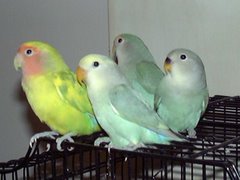All About Madagascar Lovebirds
Madagascar lovebirds are scientifically called as Agapornis cana. These lovebirds are native of Malagasy Republic and neighboring islands. Madagascar lovebirds are also called as Grey-headed love bird/Lavender headed love bird.These birds are 13.5 cm long. The male is green in color with silver-gray from head to breast. The females are green from head to breast. Domesticated reared lovebirds of this type are gray from head to breast but of slightly darker shade and covering a smaller area than on adult males; beaks partly blackish.

In wild, the Madagascar lovebirds live in large groups, though remaining in pairs. They usually tend to perch on the fringes of woodland and descend into the rice fields and plantations, where they do great damage.
In the past, Madagascar lovebird were very common and cheap to buy; Nowadays, the Malagasy Republic has banned their export and they become rarities. Newly imported specimens are shy and catch cold easily.
They usually prefer the bird room or family room. In a small cage they are rather nervous and this distract from any pleasure you may have in them. In my experience, they will breed and sleep in a budgerigar nest box by choice.
My birds only used a few sunflower seed husks and two dried leaves as nesting material, but my friends with these breeds reported that their birds used grasses, chickweed, small strips of newspaper, willow bark, pine and larch needles, cranberry and other leaves. They are known for constructing domed nest out of straw.
A clutch almost always consists of four to five eggs, which the female incubates for twenty-two days. Almost five weeks later, the young leave the nest. Young males emerge with a silver-gray head, whereas imported male young ones head is green in color.
Once the young one came out of the nest, it is the male who takes charge of them as the female immediately becomes broody again.
My Madagascar lovebird youngsters were reared almost exclusively on a diet of millet. They over winter in cold weather as long as it remains frost free. Some breeders have suffered no losses when the temperature went as low as -90 c. It is not good idea to house them with another species.







 Free Ads For Bloggers
Free Ads For Bloggers


No comments:
Post a Comment